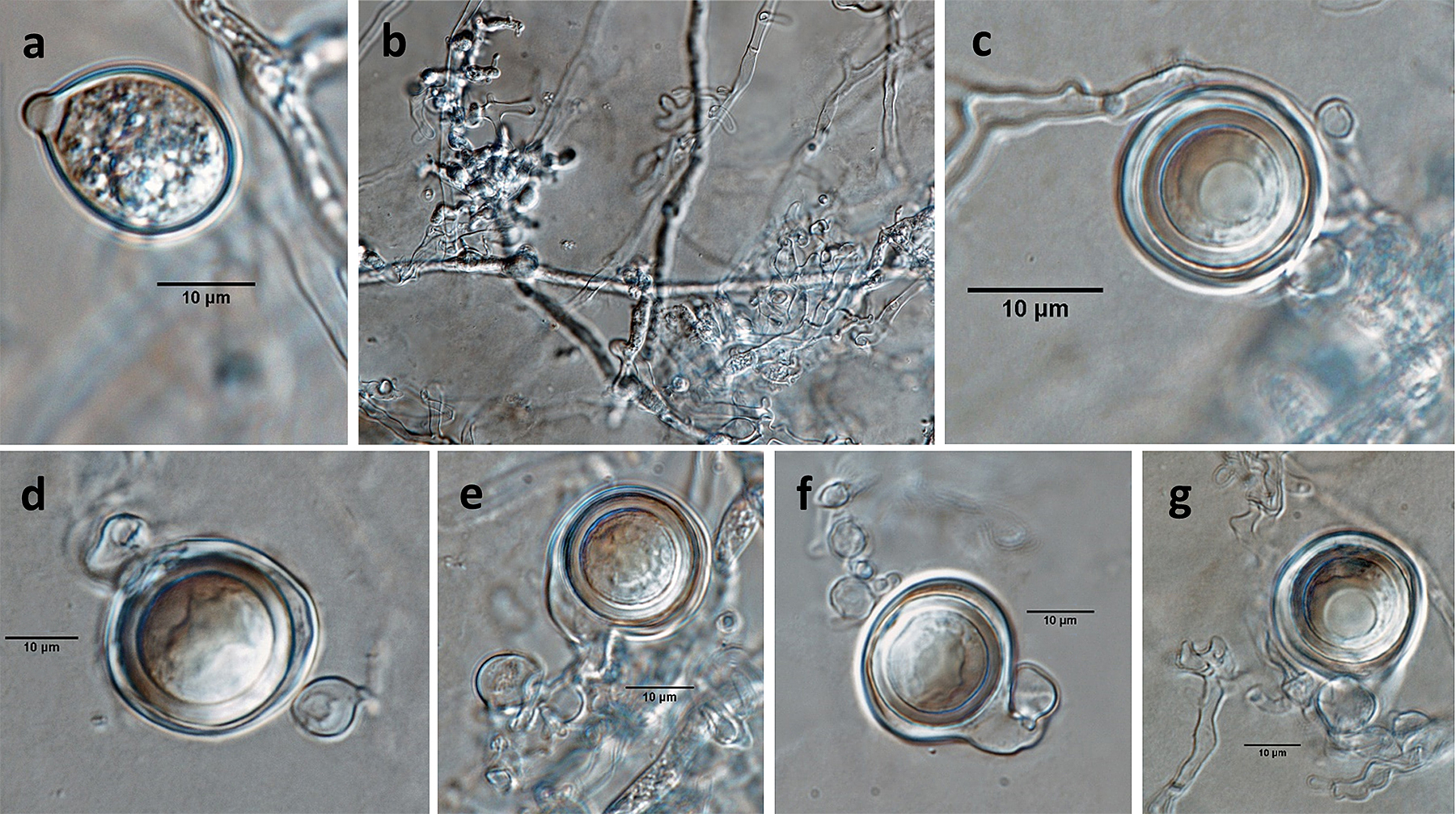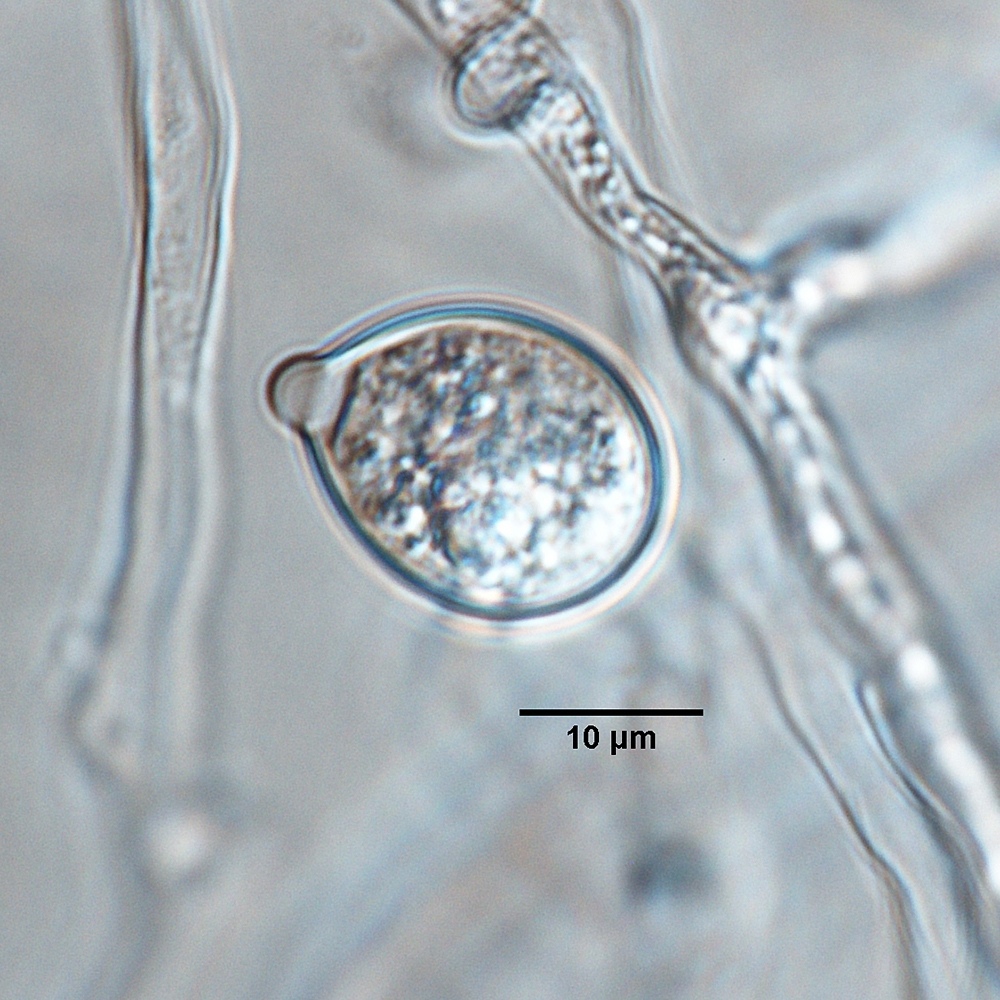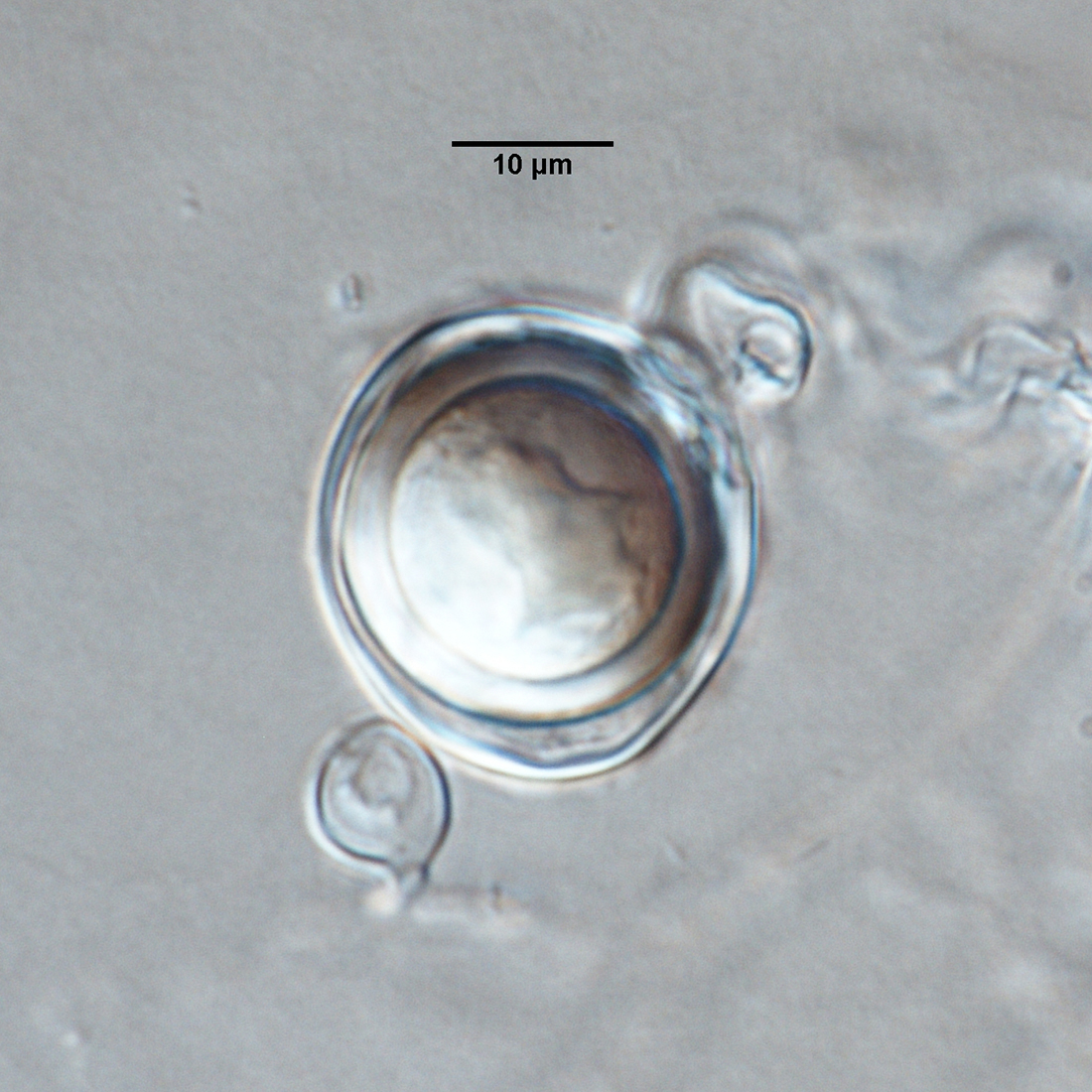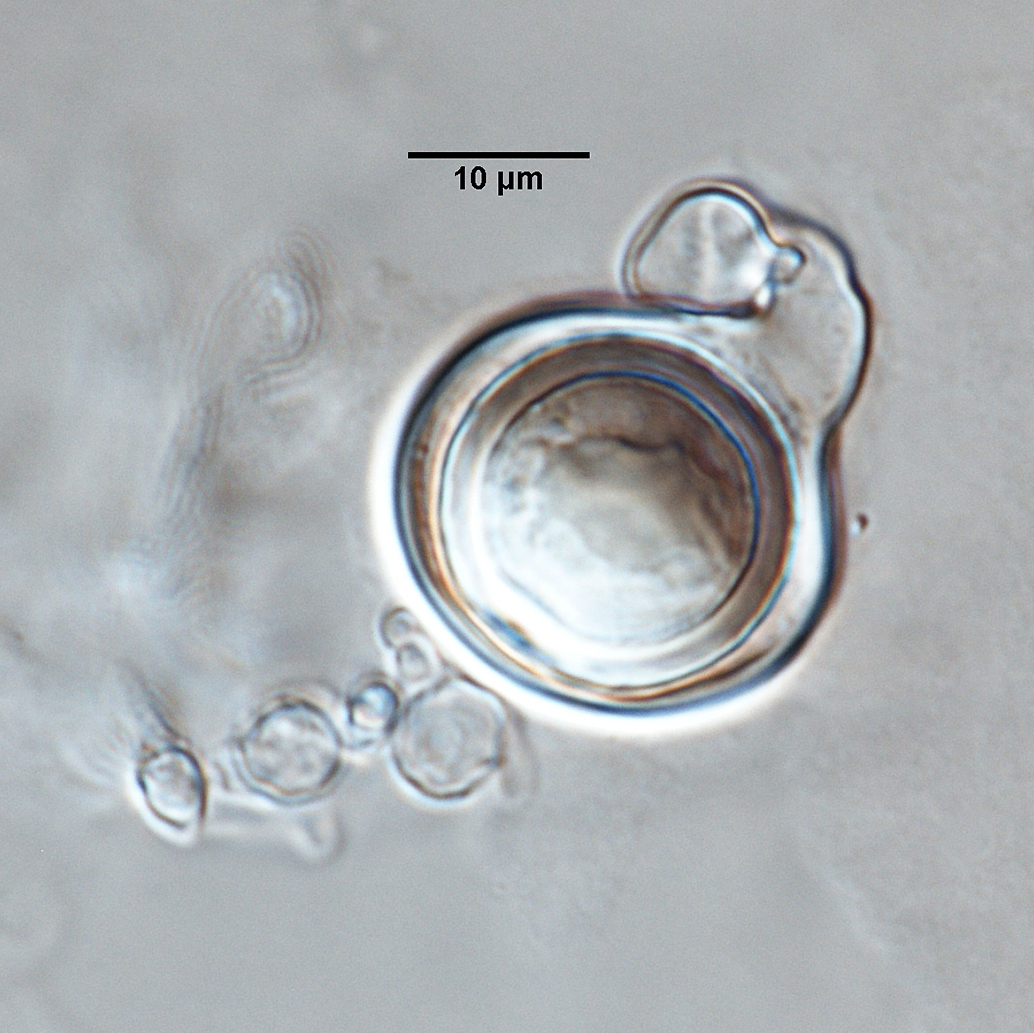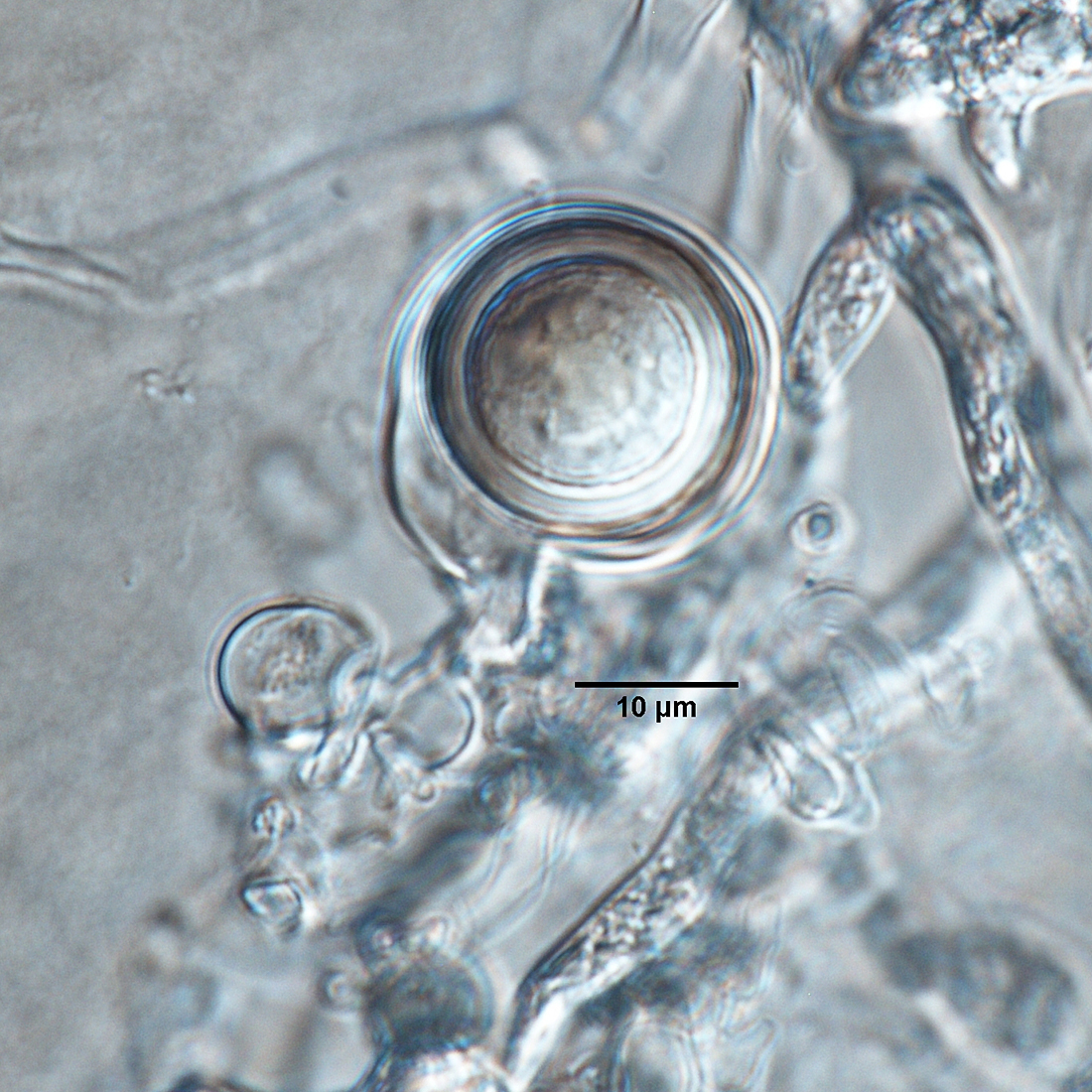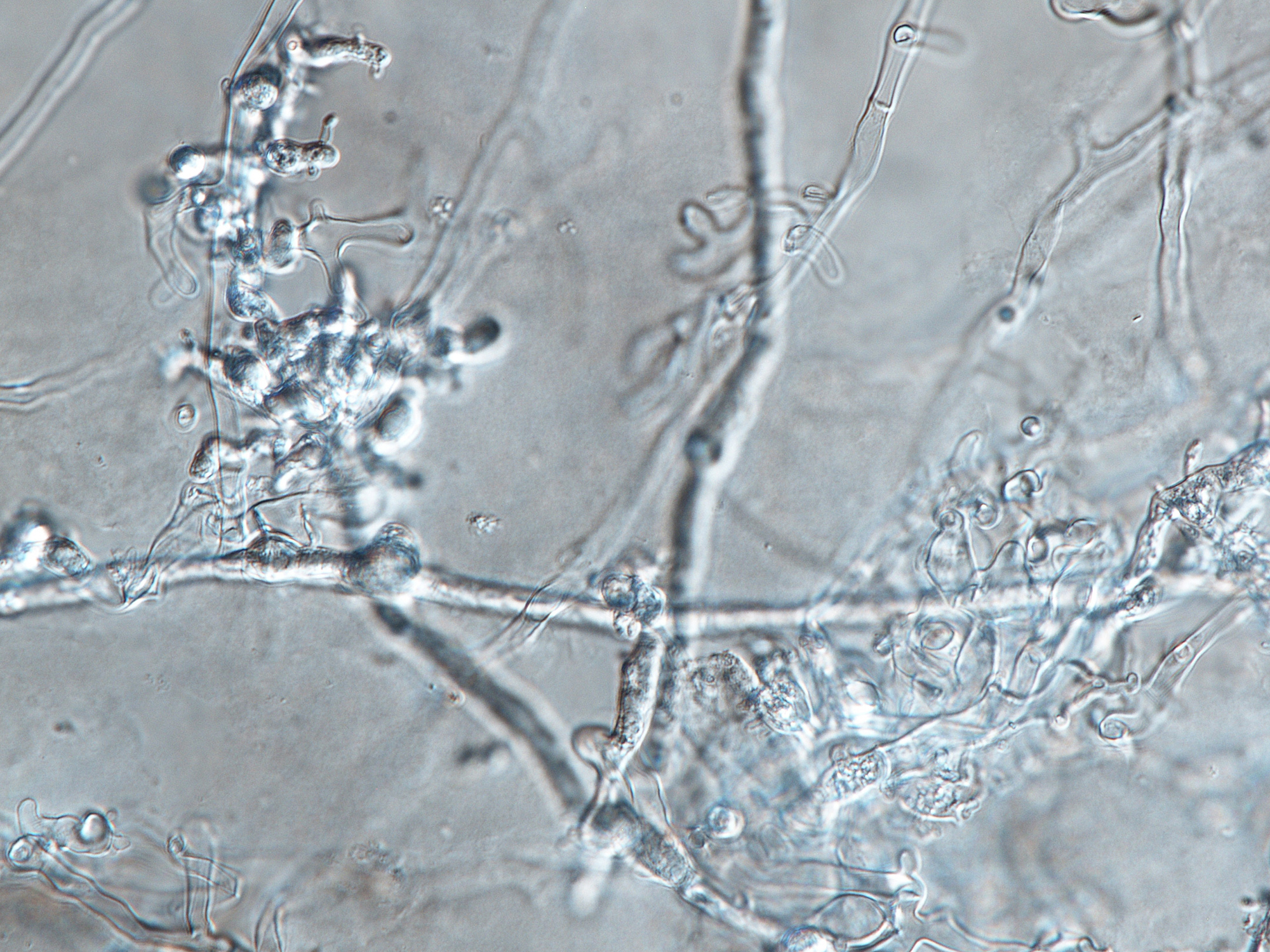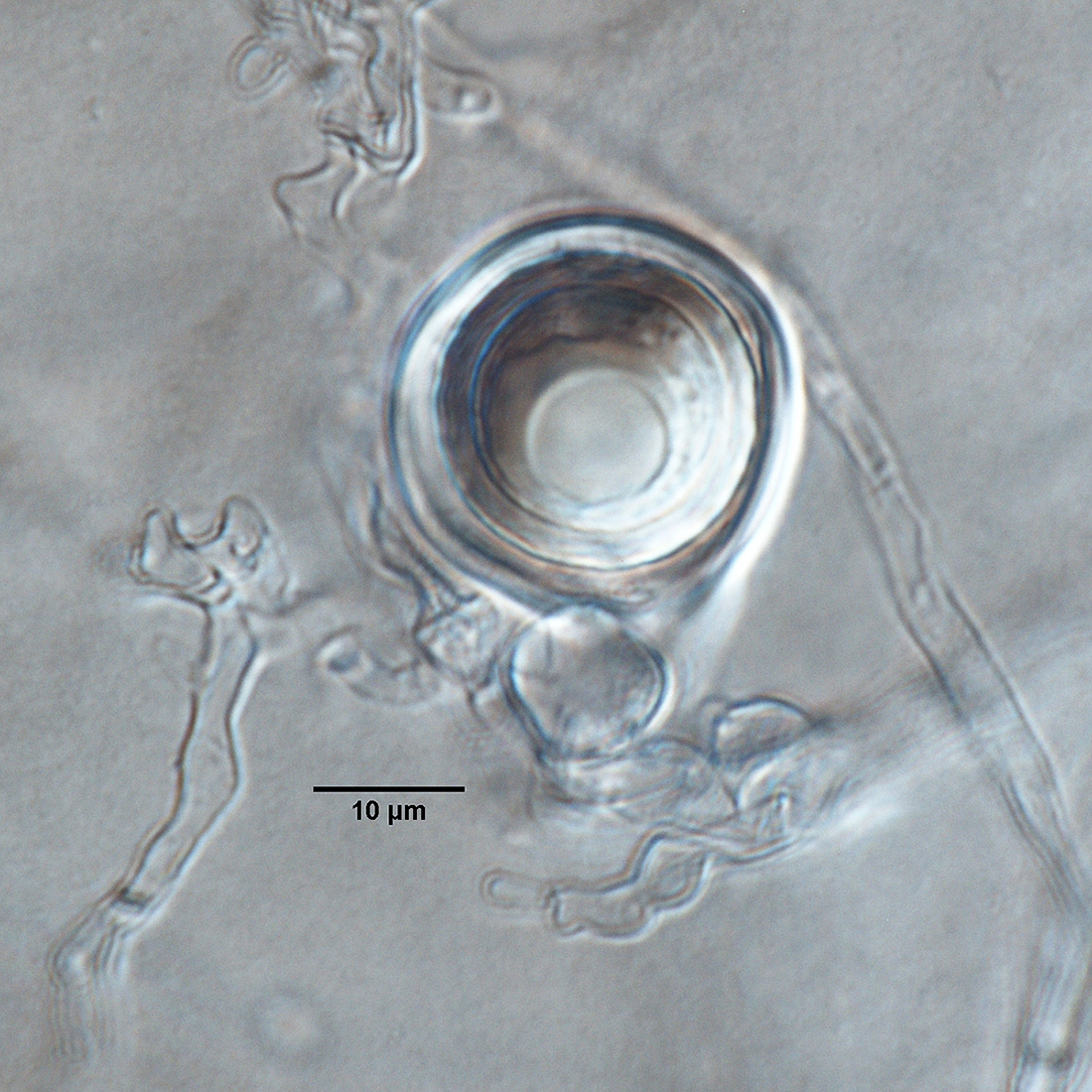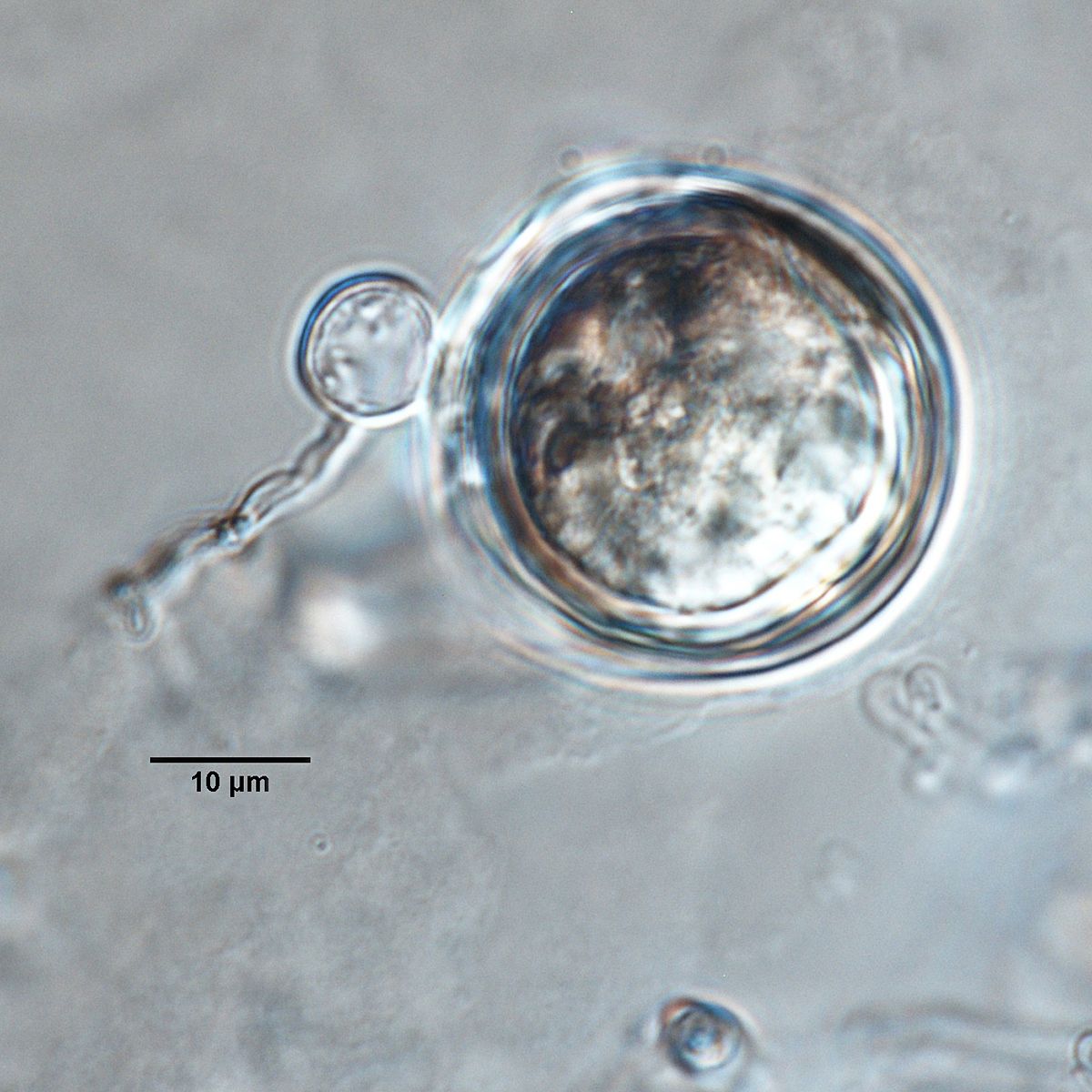Phytophthora quercetorum
|
Phytophthora spp. in Clade 4: portion of the seven-loci ML phylogeny featuring the type cultures of 212 described species (by T. Bourret). Notice the position of P. quercetorum Ex-type CBS 121119 = S&T BL 52G. Gloria Abad, USDA S&T.
|
|
Phytophthora spp. in Clade 4: Morphological Tabular key (PDF) and Tabular key legends (PDF) in IDphy2 KEY SECTION. Notice the data of P. quercetorum Ex-type CBS 121119 = S&T BL 52G. Gloria Abad, USDA S&T.
|
|
Phytophthora quercetorum (CPHST BL 52G) colonies of the ex-type grown for 7 days on (a) V8® Agar, (b) potato dextrose agar, and (c) malt extract agar; photo by Krysta Jennings and Leandra Knight, USDA-APHIS-PPQ |
|
Phytophthora quercetorum (ex-type CPHST BL 52G) asexual and sexual phases: (a) papillate persistent ovoid sporangium originated in unbranched sporangiophore, (b) coralloid mycelia, (c–g) smooth-walled oogonia with paragynous antheridia and aplerotic oospores, (e–g) oogonia with comma-shaped tapered bases; photos by Gloria Abad, USDA-APHIS-PPQ. |
|
Phytophthora quercetorum (ex-type CPHST BL 52G) asexual phase: papillate persistent ovoid sporangium originated in unbranched sporangiophore; photo by Gloria Abad, USDA-APHIS-PPQ. |
|
Phytophthora quercetorum (ex-type CPHST BL 52G) sexual phase: smooth-walled oogonium with paragynous antheridium and aplerotic oospore; photo by Gloria Abad, USDA-APHIS-PPQ. |
|
Phytophthora quercetorum (ex-type CPHST BL 52G) sexual phase: smooth-walled oogonium with comma-shaped tapered base, paragynous antheridium, and aplerotic oospore; photo by Gloria Abad, USDA-APHIS-PPQ. |
|
Phytophthora quercetorum (ex-type CPHST BL 52G) sexual phase: smooth-walled oogonium with comma-shaped tapered base, paragynous antheridium, and aplerotic oospore; photo by Gloria Abad, USDA-APHIS-PPQ. |
|
Phytophthora quercetorum (ex-type CPHST BL 52G) asexual phase: coralloid mycelia; photo by Gloria Abad, USDA-APHIS-PPQ. |
|
Phytophthora quercetorum (ex-type CPHST BL 52G) sexual phase: smooth-walled oogonium with comma-shaped tapered base, paragynous antheridium, and aplerotic oospore; photo by Gloria Abad, USDA-APHIS-PPQ. |
|
Phytophthora quercetorum (ex-type CPHST BL 52G) sexual phase: smooth-walled oogonium with paragynous antheridium and aplerotic oospore; photo by Gloria Abad, USDA-APHIS-PPQ. |
Name and publication
Phytophthora quercetorum Y. Balci & S. Balci (2008)
Balci Y, Balci S, Blair JE, Park SY, Kang S, and MacDonald WL. 2008. Phytophthora quercetorum sp. nov., a novel species isolated from eastern and north-central U.S. oak forests. Mycological Research 112: 906–916 (pp. 911).
Corresponding author: yibalci@mail.wvu.edu Yilmaz.Balci@aphis.usda.gov
Nomenclature
from Balci et al. (2008)
Mycobank
Etymology
refers to oak forests
Typification
Type: UNITED STATES OF AMERICA, isolated from the rhizosphere soil of oak (Quercus rubra), by Y. Balci in Maryland, Townhill, during July 2004; holotype: BPI 878357 (dry culture deposited to the Herbarium BPI of the Systematic Mycology and Microbiology Laboratory in MD, USA)
Ex-type: CBS 121119 and ATCC MYA-4186 (living cultures)
Sequences for ex-type in original manuscript: P15555 (WPC) = 60S Ribosomal protein L10 EU080900, β-tubulin EU080901, elongation factor 1 alpha EU080902, Enolase EU080903, Heat shock protein 90 EU080904, 28S Ribosomal DNA EU080905, TigA gene fusion EU080906
Ex-type in other collections
(ET) CBS 121119, ATCC MYA-4186, NRRL 64164, WPC P15555, S&T BL 52G (Abad)
Molecular identification
Voucher sequences for barcoding genes (ITS rDNA and COI) of the ex-type (see Molecular protocols page)
Phytophthora quercetorum isolate CPHST BL 52G (= P15555 WPC) = ITS rDNA MG865577, COI MH136969
Voucher sequences for Molecular Toolbox with seven genes (ITS, β-tub, COI, EF1α, HSP90, L10, and YPT1
(see Molecular protocols page) (In Progress)
Voucher sequences for Metabarcoding High-throughput Sequencing (HTS) Technologies [Molecular Operational Taxonomic Unit (MOTU)]
(see Molecular protocols page) (In Progress)
Sequences with multiple genes for ex-type in other sources
- NCBI: Phytophthora quercetorum CPHST BL 52G
- NCBI: Phytophthora quercetorum P15555
- EPPO-Q-bank: Phytophthora quercetorum CBS 121119
- BOLDSYSTEMS: Phytophthora quercetorum (barcoding COI & ITS)
Position in multigenic phylogeny with 7 genes (ITS, β-tub, COI, EF1α, HSP90, L10, and YPT1)
Clade clade:
a taxonomic group of organisms classified together on the basis of homologous features traced to a common ancestor
4
Morphological identification
adapted from Balci et al. (2008)
Colonies and cardinal temperatures
Colony colony:
assemblage of hyphae which usually develops form a single source and grows in a coordinated way
morphology on PDA, MEA with rosette chrysanthemum pattern. Minimum growth temperature 9°C, optimum 18–24°C, and maximum 30°C.
Conditions for growth and sporulation
Sporangia occasionally produced on culture media and abundantly produced on agar plugs immersed in soil extract water. GametangiaGametangia:
part of hypha specialized for fusion in sexual reproduction (see antheridium and oogonium)
abundantly produced in culture media.
Asexual phase
SporangiaSporangia:
sac within which zoospores form, especially when water is cooled to about 10°C below ambient temperature; in solid substrates, sporangia usually germinate by germ tubes
papillatepapillate:
pertaining to the production of a distinct papilla at the distal end of the sporangium (cf. nonpapillate and semipapillate)
and occasionally bipapillate; persistentpersistent:
pertaining to sporangia that remain attached to the sporangiophore and do not separate or detach easily (cf. caducous)
; ovoidovoid:
egg-shaped, with the widest part at the base of the sporangium and the narrow part at the apex
, elongated, or distorted shapes (25–44 L x 18–33 W µm) originated in unbranched and simple sympodial sporangiophores or intercalaryintercalary:
positioned within a hypha (cf. terminal)
in hyphaehyphae:
single, tubular filament of a fungal or oomycete thallus; the basic structural unit of a fungus or oomycete
. Sporangiophores with basal or intercalaryintercalary:
positioned within a hypha (cf. terminal)
swellings. Hyphal swellings are not observed but hyphaehyphae:
single, tubular filament of a fungal or oomycete thallus; the basic structural unit of a fungus or oomycete
often present coralloid appearance. ChlamydosporesChlamydospores:
an asexual spore with a thickened inner wall that is delimited from the mycelium by a septum; may be terminal or intercalary, and survives for long periods in soil
rarely observed and are globoseglobose:
having a rounded form resembling that of a sphere
and subglobose.
Sexual phase
Homothallichomothallic:
pertaining to sexual reproduction that can take place within a single thallus (i.e. self-fertile, non-outcrossing) (cf. heterothallic).
. OogoniaOogonia:
the female gametangium in which the oospore forms after fertilization by the antheridium
smooth-walled, globoseglobose:
having a rounded form resembling that of a sphere
(17–40 µm), frequently with comma-shaped tapered basetapered base:
pertaining to the base of a sporangium or oogonium; funnel-shaped
on oogonial hyphae; antheridiaantheridia:
the male gametangium; a multinucleate, swollen hyphal tip affixed firmly to the wall of the female gametangium (the oogonium)
paragynousparagynous:
pertaining to the sexual stage in which the antheridium is attached to the side of the oogonium (cf. amphigynous)
, cylindrical or club-shaped; oopores apleroticaplerotic:
pertaining to a mature oospore that does not fill the oogonium; i.e. there is room left between the oospore wall and oogonium wall (cf. plerotic)
or slightly apleroticaplerotic:
pertaining to a mature oospore that does not fill the oogonium; i.e. there is room left between the oospore wall and oogonium wall (cf. plerotic)
(14–33 µm).
Most typical characters
Phytophthora quercetorum is characterized by the presence of oogoniaoogonia:
the female gametangium in which the oospore forms after fertilization by the antheridium
frequently with comma-shaped tapered basetapered base:
pertaining to the base of a sporangium or oogonium; funnel-shaped
and the shape and origin of the sporangiasporangia:
sac within which zoospores form, especially when water is cooled to about 10°C below ambient temperature; in solid substrates, sporangia usually germinate by germ tubes
.
Additional specimen(s) evaluated
Phytophthora quercetorum ex-type CPHST BL 52G, duplicate of P15555 (World Phytophthora Collection)
Hosts and distribution
Distribution: North America (USA), Europe
Substrate: soil, rhizosphere
Host: Quercus alba (Fagaceae), Acer rubrum (Sapindaceae), Hedera helix (Araliaceae), Quercus robur
Retrieved February 01, 2018 from U.S. National Fungus Collections Nomenclature Database.
Additional references and links
- SMML USDA-ARS: Phytophthora quercetorum
- EPPO Global Database:
- Forest Phytophthoras of the World: Phytophthora quercetorum
- CABI Digital Library: Phytophthora quercetorum
- Encyclopedia of Life (EOL): Phytophthora quercetorum
- Index Fungorum (IF): Phytophthora quercetorum
- Google All Phytophthora quercetorum
- Google Images Phytophthora quercetorum
- Google Scholar Phytophthora quercetorum
Fact sheet author
Z. Gloria Abad, Ph.D., USDA-APHIS-PPQ-S&T Plant Pathogen Confirmatory Diagnostics Laboratory (PPCDL), United States of America.


